
A son is the best - even though born late,
-Hávamál, The Poetic Edda
When the father - no longer is alive;
By roads - there would seldom stand stones,
If sons did not raise them - to their father's memory.

A son is the best - even though born late,
-Hávamál, The Poetic Edda
When the father - no longer is alive;
By roads - there would seldom stand stones,
If sons did not raise them - to their father's memory.
I will start with the oldest runic stones we know of, and continue in order of age...
Runic Stones were raised during a very short period of time, it kind of started in the 900's in Scania, southern Sweden and Denmark and is then spread very rapidly.
Especially the ones raised in Uppland, middle Sweden between the year 1000 and the year 1100 are very easy to recognize. They are not raised to tell us something - more for showing the wonderful ornamental art that dominates the time.
Of about 5000 known runic inscriptions, 3000 are runic stones, but this does not mean that runes were used on stones, just that stone is a material that last and that runic stones have the size that they do not just disappaer so easy!
Denmark has about 250 runic stones, Norway about 100 and Sweden about 2500... Slightly different!
Of these 2500 are 1700 in Uppland/Södermanland - the two provinces around Stockholm in middle Sweden.
Runic stones are also known on former Scandinavian colonys like southern Russia, the Fareoes, Isle of Man and Greenland. Also in the United Kingdom, but they are made with the Anglo-Saxon futhark.
The tradition of raising stones were used by people long before the art of writing came to their behalf, usually one raised Bauta-stones on the battle-fields were loved ones had suffered defeat.
The first stones with carvings came in the 300's and had no ornamental art, simply runes.
Generally one can say that the runic stones are raised after a passed away person as a memory. But this is not totally clear yet, as some of the stones were buried together with the dead, maybe a way of preventing him to haunt?
Some stones have cursings on them, maybe to scare off grave-robbers?
Now why did the raising of runic stones become such a great trend in Uppland during these 100 years of time, the late Viking Age when the Christian of Sweden was almost through?
Here is one possible reason:
The new faith had new traditions concerning funerals. Before this, the Vikings used to burn the dead on his ship together with his animals and belongings and one thralless - if he were a chief, or bury him in the village's ättebacke(FAMILY-HILL). Now the Christians made grave-yards, seperated from the old ättebacke and this meant the dead person had to be divided from his old dead family and dear ones...
Maybe the runic stones were raised as a way of telling, well, he is dead and buried in the new grave-yard but here is a memory-sign of him that people will understand and accept...
And that a hundred years period of time was just enough time for people to accept the new burying ceremony and tradition and end raising memory-stones by the roads.
It is hard to tell who the rune carvers were from the oldest of time. Today, maybe only one carving from every one of them is saved for us to study.
The most famous of the oldest rune-carvers is Varin who carved the Smoke-stone in the beginning of the 800's, it is truly a literal piece of master-art.
In Denmark, the best rune carver was known as Sote and he worked in the 900's - making the longest of all runic texts from Denmark.
But from the beginning of the 1000's - we can tell that rune carving now was a proffesion, here are some of the artful carvers:
I can't tell you which of these that are the greatest, but I will share as many of all these over 3000 carvings on stones there is that I can find, and if you read them all, maybe you can choose your own favourite and maybe we could have this little voting later on???
Some of the inscriptions will have the runic inscription itself, along with the translitteration and the translation of it, and sometimes a picture too. The translitteration is when every rune is written down as a letter literally, which gives us a sence of the language and the pronunciation. Whenever a translitteration goes with the inscription, my translation will be very literal, in other cases more free, to make it sound more understandable, but still with a Scandinavian grammar. It is different from time to time. When I have any own comments, they are coloured in green...
I would prefer if you read the page "Runes" first, it consists small wav-files with pronunciation of runes and Scandinavian letters together with all other information you want/need to know.
The Picture stones is something else, they do not have any runes on them, just pictures and beautiful ornamental art, as you will get to see examples of later. They often illustrates famous legends and Sagas and other folkbelief stories and myths.
Listen and enjoy - Sons and Daughters of the rune carving people of the Great North!

... ist
... ina
... daRfaihido
... carved on this
... stone
... painted.
Runes were first carved with tools in the stone, and then painted, most often in red.
The Vetteland-stone, Norway.
Around the year 350.
... dagastiR runo faihido
... guest (the) rune painted.
Runes were first carved with tools in the stone, and then painted, most often in red.
The Einang-stone, Norway.
Around the year 350.
|
thrawijan haitinaRwas
I am called
This particular stone was found in the 19:th century, used as a bridge for a little creek between Trättelanda and Kalleby. The inscription is in only one verse, very simpel as with most old runic stones. You shall read it from down to up.
The Kalleby-stone from Tanum, Bohulän, western Sweden. |
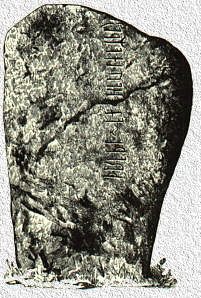
|
swabaharjaR
sairawidaR
stainawarijaR
fahido
ek hraRaR
satido ...tain
...
Swaba is murdured
Steinar painted
I Rå raised the stone.
Runes were first carved with tools in the stone, and then painted, most often in red.
The Rö-stone from Tanum, Bohulän, western Sweden.
Around the year 450.
writeR:aihuthrowati . orumalaib
was
Aihuthrow writes this
after Ormalaib.
The Myklibostad-stone, Norway.
Around the year 400.
ek hagustaldaR
thewaR godagas
I HagustaldaR
Godag's servant.
The Valsfjords flat rock, Norway.
Around the year 400.
|
ek wiwaR after woduride witandahalaiban worahto r
... R woduride |
I Wiwar, after Woduridi, my master, wrote and did this. ...for Woduridi (the) stone ... three daughters did. (HIS THREE DAUGHTERS PREPARED AND FINISHED THE STONE FOR HIM) but the grave-ale (FEAST WHERE THEY CELEBRATED THE MEMORY OF HIM) was held by heirs. |
|
This inscription consists of two freely divided parts, one on each side of the stone. At the picture to the left, you shall read from the upper right, then you switch row and read from down to up. On the side to the right on the picture, you shall start with the right row from down to up, then the middle row from up to down and at last the left row to up again.
The Tune-stone from Østfold province, Norway. |
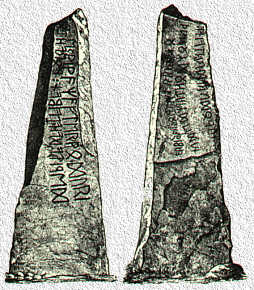
|
This is a funeral.
My dear sister Borga
may spare me.
The Opedale-stone from Hordaland, Norway.
Around the year 400.

skithaleubaR
Skin-Lovely.
Poetry! Maybe it is meaning a woman?
The Skärkind-stone from Östergötland, Sweden.
Around the year 450.
frawaradaR
anahahaislaginaR
FrawaradaR
on (the) horse is defeated.
The Möjbridge-stone from Uppland, Sweden.
Around the year 450.
alu
Mead / Ale / Beer / Stout
Alu is called Öl in Swedish today. Quite similar!
The Elgesem-stone, Norway.
Around the year 450.
Hall put Igja in barrow.
The Stenstad-stone from Telemark, Norway.
Around the year 450.
Hadulaik is barrowed here.
I Hagustald
buried my son.
The Kjølevik-stone from Rogaland, Norway.
Around the year 450.
I Wagigar Agilamundos Eril.
The Rosseland-stone, Norway.
Around the year 450.
I Wakr
know of writing.
This one just thinks he is something...
The Reistad-stone, Norway.
Around the year 500.
|
haukoþR
Barrow / Funeral.
The little R-rune tells us to read this word from up to down, as this rune often ended words.
The Vånga-stone |
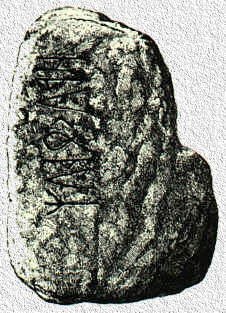
|
fino
saligatiR
The word above is a female name and the word beneath is probably a male name, maybe they are married?
The Berga-stone from Sødermanland, Sweden.
Around the year 500.
Lovely is my name.
Ravn is my name.
I, Eril, writes the runes.
Ravn means raven - and Eril seem to be the title of a rune-carver.
The Järsberg-stone from Värmland, Sweden.
Around the year 500.
I - Wiwila's Eril.
Ja, Eril definately seem to be the title of a rune carver!
The Veblungsnes-cliff from Romsdale, Norway.
Around the year 550.
|
harija:leugar
Harija (raised the stone after) Leugar
This stone is really cool, as you can see it has been carved on twice, the first time in the 500's, and then reduced 500 years later, this time with a runiform ornament within a serpent. The other is simpel without ornamental art which is common for old carvings.
The Skåäng-stone from Vagnshärad, Södermanland, Sweden. |

|

Hådulv put staves three: f f f
wealth, wealth, wealth.
Another proof that runes possesed magic powers - this one thinks he will get wealthy and rich by carving the fehu-rune ![]() three times in a row!
three times in a row!
The Gummarp-stone from Blekinge, Sweden.
Around the year 600.
After Härulv.
Hådulv, Hjorulv's descendant.
wrote these runes.
They didn't have much imagination concerning names in those days...
The Istaby-stone from Blekinge, Sweden.
Around the year 625.
With nine bucks,
with nine stallions,
gave Hådulv äring. (TO SACRIFICE FOR GOOD HARVEST)
Härulv, the son, raised (the) stone.
Honourable runes' row
I dwell here.
Restless by the distorted,
dead through slyness,
shall the one be
who breaks this.
There are some runic stones with cursings, and they seem to have worked, as the stones still aren't touched.
The Stentoften-stone from Blekinge, Sweden.
Around the year 650.
Honorable runes' row
I hid here.
Restles by the distorted,
dead through slyness,
shell the one be
who breaks this.
I see misfortune.
Another cursing, see runic inscription right above!
The Björketorp-stone from Blekinge, Sweden.
Around the year 675.
I the Eril Hror,
Hror's son,
made this flat rock.
Another Eril - with the same name as his father - another example of their imagination concerning names.
The Village-stone from Buskerud's county, Norway.
Around the year 575.
The rune I carve,
which from the Gods
origins,
I make calmness
:suhurah:susi...
hwatin
hakutho
This is a proof of what the people believed in - that the runes came from the Gods - it was Odin's gift and very sacred signs.
The Noleby-stone from Fyrunga in Västergötland, Sweden.
Around the year 700.
I Roland carved.
The Vatn-stone from Sør-Trøndelag, Norway.
Around the year 700.
Udd drove this stallion.
It is not always easy to understand what they mean...
The Roes-stone from Gothland, Sweden.
Around the year 750.
Not is (the) stone seeked by sun,
nor is it cut by iron,
nor shall no man,
expose it
while Moon down falls.
Nor shall confused men
remove it.
My beloved ones,
the heavy sea swallowed,
the ropes tore apart
with the tired mast.
Who led the army
here to the land of men?
The Human-fish,
from islands far away,
swimmed in ...
from the land ...
This one is awesome!
You will find other examples of the Vikings outstanding poetry within this site.
Delight to those who have listened - words from the High One from the Poetic Edda.
The Eggja-stone, Norway.
Around the year 700.
|
hariwuls stainaR
Härjulv's stone. This stone is from the time when the old fuþark was reduced into what we call the new modern fuþark. From 24 runes to 16! Read more about that in the runes-page! This carving consists of both old and new runes, but most old. The text shall be read from down to up.
The Foxhall-stone from Bohuslän, western Sweden. |
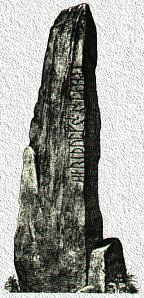
|

Vadi carved,
after Åsmund his son.
The Sölveborg-stone from Blekinge, Sweden.
Around the year 775.
Gunvald's stone,
son of Roald,
in Sallöv.
The Snoldelev-stone, Denmark.
Around the year 780.
Stygg (BAD / NORTY) made
these cairns
after Öjvind, his son.
He fell to the East
with Ejvisl.
Viking carved
and Grimulv.
Viking is still a name in these days, maybe not so common.
The Kälvesten-stone from West Stenby, Östrgötland, Sweden.
Around the year 800.
|
After Ejuls. And read these runes, which from the Gods origins, who ... Alrik painted.
Ejuls, Eirik's son,
Alrik's father
Nights and Days ...
He who wins Victory
|
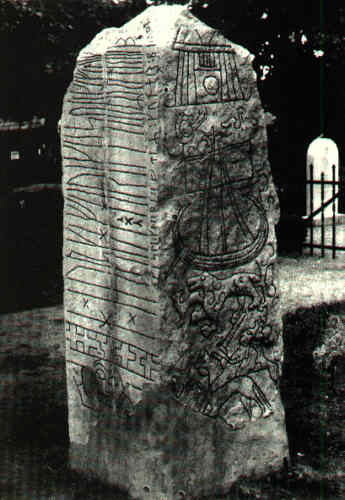
|
|
This runic stone in front of Sparlösa church in Västergötland, Sweden, was raised for its first time around the year 800. Later it became a part of the church, as a lot of other stones have too, and is today placed outside the church.
The Sparlösa-stone from Västergötland, Sweden. |
|
|
After Vämod stand these runes. But Varin wrote them, the father, after death-touched son.
Tell the youth in the ätt (SORT OF FAMILY)
Tell for the second,
Then, Tjodrik the bold
Tell for the twelvth,
Tell for the thirteenth,
Valkir five, Radulf's sons;
Now I tell all:
Tell the youth in the ätt
Tell the youth in the ätt
Tell the youth in the ätt |
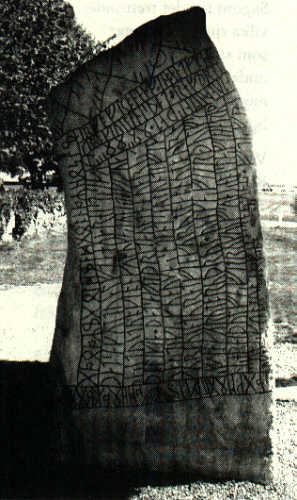
|
|
This is Sweden's most strange relic, and the text is very long and very hard to translate, as it consists of several clandestine-runes and is also made in several different runic systems and fuþarks. All this in the early ninth century!
The Smoke-stone from Östergötland, Sweden. |
|
So, the inscription has
an inscription within itself:
f u þ a r k h n i a s t b m l R
Who is in there?
The oldest of the Æsir.
Who is in there?
The sanctify-renowned.
Kolfinn fixed mead (GRAVE-MEAD / BEER = FEAST TO CELEBRATE THE MEMORY OF THE DEAD)
after his beloved father. (THIS INDICATES THAT THE FATHER HAS RECENTLY DIED)
It was covered
with runes of joy
and runes of eternity.
Every man freezes :
Out - out - out!
Bold walks he,
who does not step back,
from he,
who gives harm.
It asks who is inside the inscription within the inscription itself - the fuþark above (THE COMPLETE RUNIC ALPHABET) and answers that the oldest of the Æsir is in there - Odin, that is!
Now - go look up Odin in the glossary and read of how he got to know the secret of the runes...
The Malt-stone from Jutland, Denmark.
Around the year 850.

|
|
|
þurmutR niaut : kubls |
Tormund. Enjoy the cairn! |
|
The Swedish translation of the last row today would be: njut kummlet - not so different from the translitteration!
The Nørre Nærå-stone from Fyn, Denmark. |
|
Þjodvi raised this stone
after Odinkar.
f u þ a r k h n i a s t b m l R
enjoy the cairn well
þmkiiissstttiiilll
I put the runes correctly.
Teehee, this is as a cry of joy - first the complete runic fuþark (ALPHABET) and then two rows down this "cry of joy" - and then the satisfying comment at last: I put the runes correctly.
Hehehe
The Gørlev-stone, Denmark.
Around the year 850.
After Roulv,
who was the vouch of the Nörir, (A VOUCH WAS A MAN WHO VOUCHED FOR OTHERS, AS HE HAD EVERYBODIES TRUST)
stands this stone.
The sons raised it.
Åver painted.
Runes were first carved with tools in the stone, and then painted, most often in red.
The Flemløse-stone, Denmark.
Around the year 850.
Gunnar painted
these runes.
And he had fled guilty.
He took refuge with this Vi.
And he got free safe-conduct.
And he reconciled
to Vifinn, who painted this.
Runes were first carved with tools in the stone, and then painted, most often in red.
The flat rock of Oklunda from East Husby, Östergötland, Sweden.
Around the end of the the 800's.
|
raknhiltr sustiR ulfs sati stain þansi auk karþi hauk þansi auft auk skaiþ þaisi kunulf uar sin klamulan man sun nairbis faiR uarþa nufutiR þaibatri. |
Ragnhild, sister (of) Ulf, sat stone this and carved hög this after - and ship barrow this - Gunulv man hers (the) eloquent man son (of) Narvi. Few will be born better than he was.
NOT IN TRANSLITTERATION: |
|
Hög means barrow in English, but one can't carve a barrow - it is more symbolic, that the runic stone is the grave. This stone has a cursing on it, as some other do as well, and it is a really sad text, I think, very few will be born - better than he was...
The Tryggevælde-stone, Denmark. |

|
Ragnhild raised this stone
after Alle, the vouch of the Sölvir, (A VOUCH WAS A MAN WHO VOUCHED FOR OTHERS, AS HE HAD EVERYBODIES TRUST)
the sacred army's honorable man.
Alle's sons made
this cairn
after their father,
and his wife
after her man.
But Sote
carved the runes
after his master.
Thor sanctify these runes.
He may be distorted and unredeemed,
he who harms this stone
or raises it
as memory after another.
When Thor is "called for" as in this carving from the late 900's and / or when a stone is decorated with the Thor-hammer - then it is a reaction from people believing in the old Æsir Cult towards Chrisianity. The hammer is an "answer" to the cross and the formula "Thor sanctify ..." an answer to the Christians' formulas in prayers and other things. Before this period of time, such "formulas" haven't ever occured in the Æsir cult...
This stone does consist a cursing too - as many other, just read above..
The Glavendrup-stone, Denmark.
Around the year 900.
|
osfriþr karþi kumbl þaun aft siktriku sun sin auk knubu
Åsfrid carved cairn
Cairn in Swedish today is kummel, to compare with kumbl.
A stone from Haddeby, Denmark. |

|
Åsfrid Odinkar's daughter
made this cairn
after King Sigtrygg,
hers and Gnupa's son.
Gorm carved the runes.
Now it is the woman's daughter that has raised a stone to the memory of the same man - Sigtrygg - as her mother had. This man must be her brother...
A stone from Haddeby, Denmark.
Around the year 920.
|
kurmR kunukR karþi kubl þusi aft þurui kunu sina tanmarkaR but |
Gorm King carved kummel this after Thorvi kona his Denmark's jewel. |
Kummel means barrow in English, but one can't carve a barrow - it is more symbolic, that the runic stone is the grave.
Kona means wife.
Now Gorm's wife have died. What a beautiful kenning (AN ENG. EXAMPLE OF A KENNING IS "SHIP OF THE DESERT" FOR A CAMEL. IN ICELANDIC POETRY - KENNINGS ARE USED IN ALMOST EVERY ROW) he uses for his wife - Jewel of Denmark...
A stone from Jelling, Denmark.
Around the year 925.
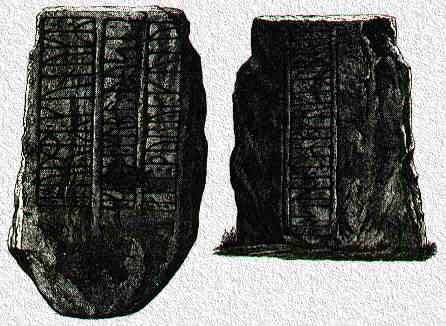
|
King Harald asked to get these cairns done after Gorm, his father and after Thorvi, his mother. This was Harald that alone conquered entire Denmark and Norway, and made the Danish Christians. Now both Denmark's jewel and King Gorm is dead, their son Harald is the new King and he seems to claim that he have made the Danish Christians, which isn't completely true, if we are to believe in runic stones raised by common people...
A stone from Jelling, Denmark. |
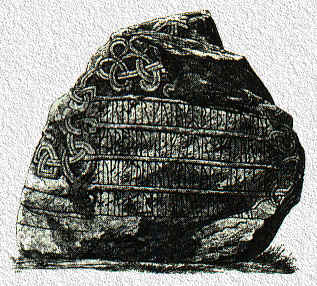
|
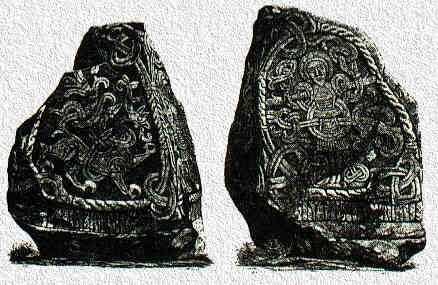
|
|
Tove, Mistivoj's daughter,
Harald the Good's,
Gorm's son's wife,
let raise this cairn
after her mother.
The Sønder Vissing-stone, Denmark.
Around the year 970.
King Sven raised the stone
after his housecarl Skarde,
who went to the West,
but now found death
by Hedeby.
A stone from Haddeby, Denmark.
Around the year 970.
Thorulv, Sven's housecarl,
raised this stone
after his friend Eirik,
who found death,
when warriors besieged Hedeby.
But he was Captain
on a longship,
a very good man.
A stone from Haddeby, Denmark.
Around the year 980.
Germund ...
made these memories
after Sasser.
Star raised (the) stone
after the dead.
Thor sanctify these cairns.
When Thor is "called for" as in this carving from the late 900's and / or when a stone is decorated with the Thor-hammer - then it is a reaction from people believing in the old Æsir Cult towards Chrisianity. The hammer is an "answer" to the cross and the formula "Thor sanctify ..." an answer to the Christians' formulas in prayers and other things. Before this period of time, such "formulas" haven't ever occured in the Æsir cult...
The Virring-stone, Denmark.
Around the year 980.
|
sur sati stin þinsi haft asku bruþur sin ian uarþ tuþr a ku þur uiki runaR
Sur sat stone
This stoen was made squared when it was to be used in a church.
The Sønder Kirkeby-stone, Denmark. |
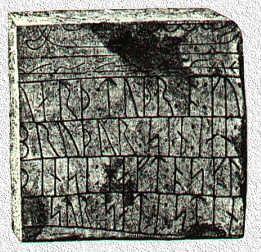
|
Tyrvi raised (the) stone
after Ogmund,
her husband,
a very good man.
Thor sanctify.
When Thor is "called for" as in this carving from the late 900's and / or when a stone is decorated with the Thor-hammer - then it is a reaction from people believing in the old Æsir Cult towards Chrisianity. The hammer is an "answer" to the cross and the formula "Thor sanctify ..." an answer to the Christians' formulas in prayers and other things. Before this period of time, such "formulas" haven't ever occured in the Æsir cult...
The Velanda-stone from Västergötland, Sweden.
Around the year 990.
|
This stone is raised after Sibbe the Wise Foldar's son, but his followers raised ...
Brought down lies the followed
The Karlevi-stone from Öland, Sweden. |

|
Sandar raised (the) stone
after Joar, his friend.
Nobody will bear
a more dashing son.
Thor sanctify.
When Thor is "called for" as in this carving from the late 900's and / or when a stone is decorated with the Thor-hammer - then it is a reaction from people believing in the old Æsir Cult towards Chrisianity. The hammer is an "answer" to the cross and the formula "Thor sanctify ..." an answer to the Christians' formulas in prayers and other things. Before this period of time, such "formulas" haven't ever occured in the Æsir cult...
A stone from Korparbo, Södermanland, Sweden.
Around the year 1000.
Gunulv and Ögot
and Aslak and Rolf
raised this stone
after their friend Ful. (UGLY)
He found death ...
when the Kings fought.
The "time-placement" could point to the Battle at Svolder as an historical event.
A stone from Århus, Denmark.
Around the year 1000.
Torkel raised this stone,
after his son Gunne,
who found death in battle,
when Kings fought.
The "time-placement" could point to the Battle at Svolder as an historical event.
The Råda-stone from Västergötland, Sweden.
Around the year 1000.
|
rhafn uka tufi hiau runaR þasi aft þurui trutnik sina
Ravn descendant (of) Tuvi,
Ravn means raven.
The Læborg-stone, Denmark. |
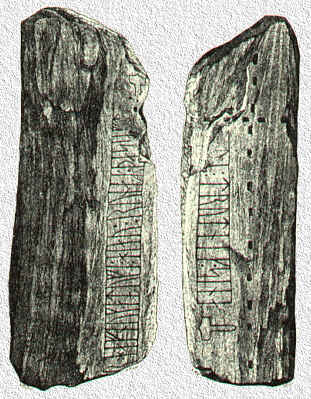
|
Tue, Ravn's descendant
and Funden and Gnyple,
the three of them made Thyra's barrow.
Ravn does still mean raven.
The Bæcke-stone, Denmark.
Around the year 1000.
Svenne raised this stone
after his father
Toste the Bright,
a very god farmer.
He who moves the stone
may be distorted and unredeemed.
Sorry, Svenne, but if I don't remeber wrong, this stone was recently moved to another place...
The Glemminge-stone from Scania, southern Sweden.
Around the year 1000.
... raised this stone
after Orökia and Kada,
his two brothers
...
May he be seen
as a distorted
and a beast
the man,
that harms this memory.
Cursings seem to be popular!
The Sønder Vinge-stone, Denmark.
Around the year 1000.
Sasgerd, Finulv's daughter,
raised (the) stone
after Odinkar,
Husbjörn's son,
the prescious
and drott-loving. (DROTT MEANS KING)
A beast may
the man be
who breaks
these cairns.
Have you noticed that most of the stones with cursings are Danish? Remember that southern Sweden was Danish too in these days, like the provinces: Scania, Blekinge, Småland and Halland.
The Skern-stone, Denmark.
Around the year 1000.
|
klibiR auk asa risþu kuml þusi uftiR ulf
Kleppi and Åsa
Kummel means cairn.
The Tullstorp-stone from Scania, southern Sweden. |
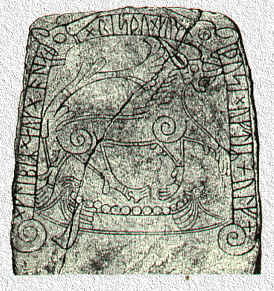
|
Eskil raised this stone
after Toke, son of Gorm,
his gentle master.
He did not flee
at Uppsala.
His fighters ran
after their brother.
The stone on the mountain
stands still
with runes.
They went into battle
closest to him,
Toke, son of Gorm.
The inscriptions may mean the battle at Fyrisvallir, which would have taken place somewhere around 990.
The Hällestad-stone from Scania, southern Sweden.
Around the year 1000.
Saske raised this stone
after his friend in battle
Esbjörn, son of Toki.
He didnot flee
at Uppsala,
but fought
as long as
he had weapons.
Which is the same as telling how manly and brave he was. *sigh* Isn't it rather stupid?
The Sjörup-stone from Scania, southern Sweden.
Around the year 1000.
Åsbjörn and Tumme
they raised this stone
after Ro and Lekfred,
sons of Gunne Hand.
Stone from Hunnestad, Scania, southern Sweden.
Around the year 1000.
Åsbjörn raised this stone
after Tumme, son
of Gunne Hand.
This will sound all weird - but Tumme means Thumb and you know what a Hand is...
Really funny names!
Stone from Hunnestad, Scania, southern Sweden.
Around the year 1000.
Fader let carve
these runes
after his brother Assur,
who found death
up North while in Viking.(TO BE OUT TRAVELING)
Stone from Västra Strö, Scania, southern Sweden.
Around the year 1000.
Fader let carve
this stone
after Björn, (BJÖRN MEANS BEAR)
who owned ship
with him.
Fader means father - but it also a name. I will have a section with old Nordic names in my Viking section - read them and get a good laugh...
Stone from Västra Strö, Scania, southern Sweden.
Around the year 1000.
|
hailki raisti stain than aft kaitil bruþur sin.
Helge raised stone
The Tu-stone from Jæren, Norway. |
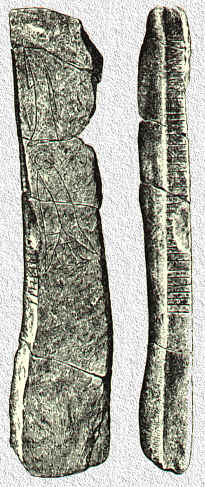
|
Tore Hordsson
raised this stone
after Åsgerd, his wife,
daughter to Gunnar,
brother to Helge on Klepp.
The Klepp-stone from Jæren, Norway.
Around the year 1000.
Gunvor made bridge,
Trydrik's daughter,
after Astrid,
her daughter.
She was the
most handy maiden
in Hadeland.
The Dynna-stone from Hadeland, Norway.
Around the year 1000.
Rodsten and Eliv,
Åke and Håkan,
raised, the four Swedes,
after their father
an impressive cairn,
after Kali, the dead.
Therefore shall the good man's
memory live
as long as the stone stands
along with the runes.
The Nöbbele-stone from Småland, Sweden.
Around the year 1000.
Assur made
this cairn
after Önd, his father.
He was not a skinflint
among other men
nor cheap with food
nor did he hurry for vengeance.
In his God
the good man believed.
Aww, isn't this too sad??? Why can't the bad people die instead?
The Rörbro-stone from Småland, Sweden.
Around the year 1000.
Rolf and Äskil
raised this stone
after Livsten, his father.
He died in Scania,
in Gardstanga,
and they brought him
to Finnveden.
The Forsheda-stone from Småland, Sweden.
The 10:th century.
Bise raised this stone
after Torgöt Vinvalit,
his father.
These both: Bise and Gunna,
raised the stone.
Tistel, Mistel, Kistel.
The Ledberg-stone from Ledberg, Östergötland, Sweden.
Around the year 1000.
Torgärd raised this stone
after Assur, her uncle,
who lived his last day to the East,
in Greece.
The good farmer Gulle
begot five sons:
Fell in Föret
did the brave fighter Åsmund.
Assur lived his last day
to the East in Greece.
Halvdan was
in Bornholm killed.
Kåre died at Dundee.
Dead is also Boe.
Torkel carved the runes.
Isn't this one just too sad as well???
The good farmers begot five sons - and then then the names of five men and all have died...
Let's hope he begot some daughters too!
The Högby-stone from Östergötland, Sweden.
The 10:th century.
Rodvisl and Rodälv
they let raised (the) stones
after their three sons.
This stone
after Rodfos.
He was never betrayed by friends
when he was away.
God help Rodfos sol.
God turn his back on those,
who turned their backs on Rodfos.
Rodvisl, Rodälv and Rodfos - and I don't even know what Rod means.
The Sjonhem-stone from Gothland, Sweden.
AThe 10:th century.
Here shall stand
a stone as a relic
glaring on the mountain
and with a bridge in front.
Rodbjörn carved
these runes,
Gairlaiv some of them,
as he knows well.
This is one inscription where the word bridge is used instead of runic-stone. They often call the stone a bridge for the soul, and here is one possible reason:
These stones are always raised next to water of some kind, to mark a fordable place in for example a river. Not a bridge in that sentance but a place where it was OK to wade over. To raise such a stone took time and knowedge, and why would people raise bridge stones for others? I mean, they already knew where to wade...
Maybe because it was a good action, and many good actions led to Heaven after death. Maybe that is why they are called a bridge for the soul - because it was a way for the raiser/carver to assure his way/bridge for his soul to heaven?
The Hogrän-stone from Gothland, Sweden.
AThe 10:th century.
|
Gislög let do these relics after Tord, also Slode let them be done. It is true, as it is said and as it was ment.
The flat rock from Gisle, Aspö, Södermanland, Sweden. |
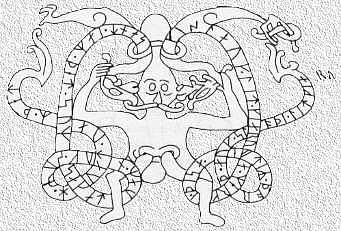
|
The stone was carved by Äsbjörn
painted as a memory
he decorated it with runes.
Gylla raised it
after Gerbjörn her husband,
and Gudfrid
after his father.
He was the best
farmer in Kil.
Read this if you can.
Runes were first carved with tools in the stone, and then painted, most often in red.
The Nybble-stone from Södermanland, Sweden.
The 10:th century.
|
helki auk fraukaiR auk þorkautr raistu merki si Run at þiuþmund faþur sin
Helge and Frågar
Marks meaning relics.
The Stenkvista-stone from Södermanland, Sweden. |
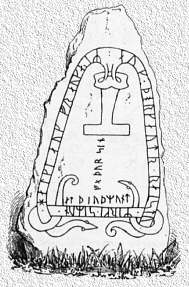
|
Here shall stand
these stones
red by runes.
Raised them did Gudlög
after his sons
and Hjälmlög
after his brothers.
Red by runes means that they painted the carved runes red, just like we do today to keep the texts readable.
Stone from Överselö, Södermanland, Sweden.
The 10:th century.
Tore and Halvard
raised this stone
after Ulv
...
Twelve winters
had Christianity
been in Norway.
The Kuli-stone from Nord-Møre, Norway.
Around the year 1010.
|
kina let lekia stin þensi auk tuki |
Gina let lie stone this, and Toke. |
|
This is the London stone from S:t Paul's cementary. It is made by a Danish rune carver. The animal have a lot of similarities to the animals at other Danish / Scanian stones you will find pictures of on this page. The normal translation of the runic carving is: Gina and Toke let lie this stone.
The London-stone from England, United Kingdom. |
|
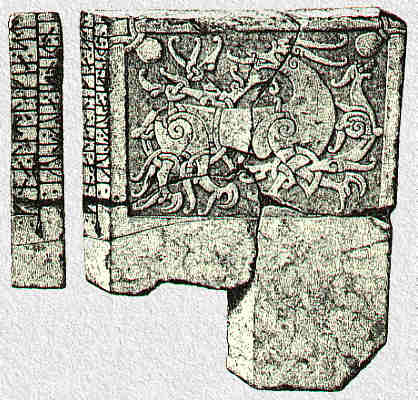
|
|

|
tula lit raisa stain þins at sun sin haralt bruþur inkuars thaiR furu trikila fiari at kuli auk a ustarlar ni kafu tuu sunarla a sirklanti. |
Tula let raise stone this after son hers Harald brother (of) Ingwar. They went manfully far after gold and (to) the East (the) eagle gave (...FOOD) died (to the) south a(IN) Särkland. |
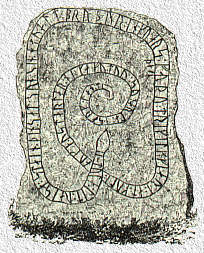
|
|
The Gripsholms-stone from Södermanland, middle Sweden. From the middle of the 10:th century. | ||
This runic inscription tells us about one of the greatest Viking raids to the east, led by the ship-chief Ingwar den vittfarne(INGWAR HE WHO HAS WIDELY TRAVELED) who went to Gardarike (PRESENT RUSSIA) and to Särkland (PRESENT IRAQ). The raid had no success and no one returned home to their motherland Sweden.
This event was kept alive orally by the people in Scandinavia and was later on written down on Iceland in the 1100's, and that Saga can most certain be found in a good book-store today.
When the news about the travellers "death to the south in Särkland" reached their families in Sweden, they raised runic stones to the memories of their loved ones. In all, 25 stones are known today.
Sadly though, no surviving stones tells of Ingwar himself. But the text above is from a stone raised by his mother and tells about his brother Harald who also had joined this raid to the south.
The stone remained part of a stariway in Gripsholm's castle until 1827, when it was then placed outside the castle.
This stone in just one verse tells of the dramatic life of a Viking:
sail off - kill - be killed...
Alrik raised the stone,
son of Sigrid,
after his father Spjut.
He to the West
had been,
He has broken a stronghold
and won victory.
How to conquer
he knew well.
Spjut means spear.
The Kjula-stone from Södermanland, Sweden.
The 11:th century.
Gunnar raised
this stone
after Lydbjörn,
his son.
The Earth shall crevice
and the sky above.
This sound like Ragnarök - when the world is destroyed and the Gods die.
The Lindö-stone from Södermanland, Sweden.
The 11:th century.
Sigrid made bridge this,
mother (of) Alrik,
daughter (of) Orm,
for soul (of) Holmger,
father (of) Sigröd,
husband hers.
Orm means snake.
The picture beneath shows the carving on the Ramsunds-mountain, not far from Eskilstuna.
This is one inscription where the word bridge is used instead of runic-stone. They often call the stone a bridge for the soul, and here is one possible reason:
These stones are always raised next to water of some kind, to mark a fordable place in for example a river. Not a bridge in that sentance but a place where it was OK to wade over. To raise such a stone took time and knowedge, and why would people raise bridge stones for others? I mean, they already knew where to wade...
Maybe because it was a good action, and many good actions led to Heaven after death. Maybe that is why they are called a bridge for the soul - because it was a way for the raiser/carver to assure his way/bridge for his soul to heaven?
The picture have nothing to do with the text - they show scenes from the famous Sigurds Fafnesbane's Saga.
The whole runiform is within a snake with a dragonhead which can be seen to the left. Then there is the headless corpse of Regin, the betraying smith and Sigurd's stepfather. His head lies next to him. Sigurd himself is sitting next to the fire and is frying the dragons heart over the fire. He has burnt his thumb when he felt on the hot heart so he puts it into his mouth to cool it and therefore - he gets dragon blood in him. Therefore, he knows the birds songs. The birds symbolic role can be seen to - they are in the tree, next to Sigurd's horse Grani.
The carving from Ramsunds-mountain, Södermanland, Sweden.
The 11:th century.

I know Håsten
and Holmsten, the brothers,
have most knowledge of runes
among the people in Midgard.
They raised stones
and rune-staffs many
after Frösten
their father.
Aha, Midgard is mentioned as the world of the humans in a stone from the Christian century!
The Fyrby-stone from Södermanland, Sweden.
The 11:th century.
Ulvkel and Arnkel and Gye
they made a thing here. (THING HERE MEANING COURT)
Not shall a memory
be greater
than what Ulv's sons
made after him,
the good young men
for their father.
They raised the stones
and made the rune-staff
even the big one
as a sign og honor.
Also Gyrid
loved her husband.
Therefore in sorow
shall he be singed of.
Gunnar carved the stone.
This text is divided on two stones.
The Arkils Thingstad-stone from Bällstad, Vallentuna, Uppland, Sweden.
The 11:th century.
|
fasti lit hkua runar þisar iftR fastulf sun sin.
Faste let carve
Faste and Fastulf - what imagination they had for given their children names.
The flat rock from Sursta, Vallentuna, Uppland, Sweden. |
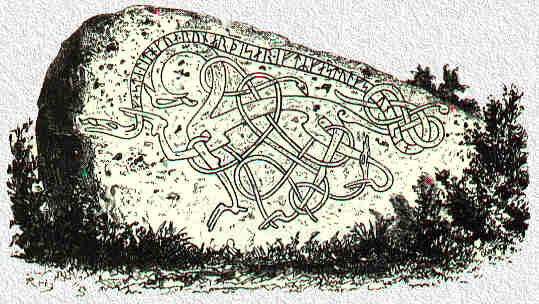
|
Ingelv let raise (the) stone
after Brune,
her husband.
He died in Denmark
in white clothes.
Balle carved.
It seems to me as in white clothes is symbolic, like a kenning (AN ENG. EXAMPLE OF A KENNING IS "SHIP OF THE DESERT" FOR A CAMEL. IN ICELANDIC POETRY - KENNINGS ARE USED IN ALMOST EVERY ROW) for something. But I don't know!
The Amnö-stone from Uppland, Sweden.
The 11:th century.
Karse and ...
let raise this stone
after Ulv, their father.
God and God's mother (MEANING JESUS AND MARY)
help his soul.
And Ulv have in England
taken three debts.
The first was
it which Toste owed him.
Then what Torkel owed him.
Then what Knut owed him.
This carving was divided into two stones, but one is missing - the reconstruction is based upon drawings of the first stone before it disappaered.
The Yttergärde-stones from Orkesta, Uppland, Sweden.
The 11:th century.
Vidhugse let raise this stone
after his good father SäRev.
He lived in Ågersta.
Here shall stand
stone between villages.
The man shall read,
who wise of runes is,
the runes,
that Balle carved.
Balle the Red is a famous carver during this century.
The Ågesta-stone from Uppland, Sweden.
The 11:th century.
You read the runes!
Germund got Gerlög
as his wife when she was a maiden.
They begot a son
before Germund drowned.
Then the son died.
After that, she got Gudrik
as her new husband. He ...
...
Then they begot children.
But only one girl
lived left,
her name was Inga.
Ragnfast in Snottsta got her
as his wife.
Then he died
and their son right after.
And the mother inherited
her son.
Then Inga remarried
with Erik as her man.
Then she died.
Then Gerlög inherited
Inga, her daughter.
Torbjörn Skald (A SKALD IS A POET WHO MAKE SONGS)
carved the runes.
Uh-oh! I can't read this piece too many times - it is too horrible! Poor Gerlög, she married young and begot many children, of which only little Inga survived until adult age. And both her men died. And Inga too married young and faced the same destiny as her mother - her first man and son died, and after remarrying - she died too.
Poor, poor Gerlög, old and alone and all her children dead - and one grandchild too.
Life was tough in those days!
Don't forget to read the two following inscriptions:
The Hillersjö-flat rock from Uppland, Sweden.
The 11:th century.
Inga let carve the runes
after Ragnfast,
her husband.
He alone owned this village
after Sigfast,
his father.
God help their souls.
This stone is from Inga, daughter of Gerlög, and I assume you have read the carving right above. Read the next one too:
A stone from Snottsta, Uppland, Sweden.
The 11:th century.
Inga raised rune-staff
and rune-stone
after Ragnfast,
her husband.
She inherited
her child.
Read the two runic stones right above.
Another stone from Snottsta, Uppland, Sweden.
The 11:th century.
Alle let raise this stone
after himself.
He took Knut's debt
in England.
God help his soul.
He did not have too low self-esteem, or what do you think?
The Väsby-stone from Uppland, Sweden.
The 11:th century.
Ragnvald let carve the runes
after Fastvi,
his mother,
Onäm's daughter.
She died in Ed.
God help her soul.
The runes let
Ragnvald carve.
He was in Greece,
he was the chief of the Sea-warriors.
On a stone from Ed, Upplands Väsby, Uppland, Sweden.
The 11:th century.
|
iarlabaki lit raisa stain þisa at sik kuikuan auk bru þisa karþi fur ont sina auk ain ati alan tabu kaþ hialbi ont hans
Jarla Banke let raise |
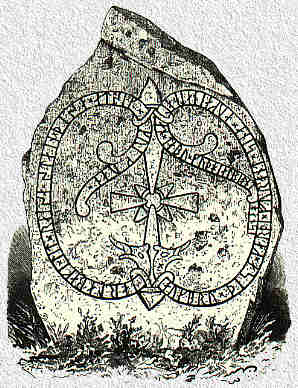
|
Quick is an old word meaning "alive", in Swedish today spelled: kvick, coming from the this Old Norse word: kuikuan. What the sentence says is that Jarla Banke raised the stones after himself while he was till alive, living.
The cross is a way for Jarla Banke to tell others he is a Christian.
This is one inscription where the word bridge is used instead of runic-stone. They often call the stone a bridge for the soul, and here is one possible reason:
These stones are always raised next to water of some kind, to mark a fordable place in for example a river. Not a bridge in that sentance but a place where it was OK to wade over. To raise such a stone took time and knowedge, and why would people raise bridge stones for others? I mean, they already knew where to wade...
Maybe because it was a good action, and many good actions led to Heaven after death. Maybe that is why they are called a bridge for the soul - because it was a way for the raiser/carver to assure his way/bridge for his soul to heaven?
The Jarla Banke-stone from Täby, Uppland, Sweden.
The 11:th century.
Östen and Jorund and Björn,
the brothers raised
after their father.
God help his spirit and soul,
forgive him crimes and sins.
As long as men live
this bridge shall lie
hard to break
and wide after the good one.
Svenner made it
after his father.
Not can a better
bridge-stone be raised.
This is one inscription where the word bridge is used instead of runic-stone. They often call the stone a bridge for the soul, and here is one possible reason:
These stones are always raised next to water of some kind, to mark a fordable place in for example a river. Not a bridge in that sentance but a place where it was OK to wade over. To raise such a stone took time and knowedge, and why would people raise bridge stones for others? I mean, they already knew where to wade...
Maybe because it was a good action, and many good actions led to Heaven after death. Maybe that is why they are called a bridge for the soul - because it was a way for the raiser/carver to assure his way/bridge for his soul to heaven?
The Sälna-stone from Uppland, Sweden.
The 11:th century.
Ingrid let make the bridge
and carve the stone,
after Ingmar, her husband,
and after Dan
and after Banke,
her sons.
They lived in Runby
and owned a farm there.
Christ help their soul.
This shall stand
for the memory of the men
as long as man lives.
This is one inscription where the word bridge is used instead of runic-stone. They often call the stone a bridge for the soul, and here is one possible reason:
These stones are always raised next to water of some kind, to mark a fordable place in for example a river. Not a bridge in that sentance but a place where it was OK to wade over. To raise such a stone took time and knowedge, and why would people raise bridge stones for others? I mean, they already knew where to wade...
Maybe because it was a good action, and many good actions led to Heaven after death. Maybe that is why they are called a bridge for the soul - because it was a way for the raiser/carver to assure his way/bridge for his soul to heaven?
A rock in Runby, Uppland, Sweden.
The 11:th century.
Estrid let raise these stones
after Östen, her husband,
who went to Jerusalem
and died in Greece.
The Broby bridge from Uppland, Sweden.
The 11:th century.
|
uisti yk alfton litu akua stin yftir ulmo faþur sen yk ulfast bruþur sen lifsten risi runi þisa
Visäte and Halvdan
This stone is carved by Livsten - one of the greatest rune carvers of all - just look at his ornamental art in the picture to the right...
The Sala Landskyrka-stone from Västmanland, Sweden. |

|
The good farmer Holmgöt
let raise the stone
after Odendisa
his wife.
A better housewife
who runs the farm
can never come
to Hassmyra.
Balle the red
carved these runes.
To Sigmund
was Odendisa
a good sister.
Awwww, another *sniff*-stone!!!
How come they do these sad texts???
<:*-C
The Hassmyra-stone from Västmanland, Sweden.
The 11:th century.
Tjuder and Gudleif and Karl,
all of the brothers
let raise this stone
after Thudmund, their father.
God help his soul
and God's mother.
Åsmund Kåresson
carved these runes correctly.
Then Emund sat.
Emund was a King until around the year 1060, when he died.
God and God's mother is Jesus and Mary.
A stone from Gästrikland, Sweden.
The 11:th century.
Unnulf and Fjolvar
raised this stone after Djure,
their father, Redulf's son,
and for Haurlaug, their mother,
Fjolvar's daughter in Viksta.
As you can see there were often special family names. Here, Fjolvar, Djure and Haurlaug's son, had the same name as his grandfather.
A stone from Hälsingland, Sweden.
The 11:th century.
Östman, Gudfast's son,
let raise this stone
and make this bridge,
and he let Christianize Jämtland.
Åsbjörn made the bridge.
Tryn carved
and Sten
these runes.
This stone was obviously raised by a new bridge.
A stone by the Öststait from Jämtland, Sweden.
The 11:th century.
Christ, Mary's son,
helpt them who built
this church,
Absalon archbishop
and Äsbjörn Mule.
A stone from Scania, Sweden.
Around the year 1200.
Karl made the stone after Björn, his friend,
Sven's and Bänkfrid's son i Hammarby,
his...
Here he lies under this stone.
Bänkfrid...
his son.
Hammarby and Botkyrka are both parts of Stockholm today.
A grave monument in Botkyrka church, Stockholm, Sweden.
Around the year 1150.
Here lies Turgillus,
son of Mr. Gudmund Gås.
Do not walk away from here,
stay and see and read
your prayers for Tyrgil's soul!
I greet you Mary,
full of mercy.
The Lord is with thy.
Blessed be thou
among women
and blessed your fruit of life.
Amen.
In your hands, Lord.
A grave-slab from Småland, Sweden.
Around the year 1300.
This stone
let housewife Rudvi make
over her husband,
Jakob in Mannagården,
who was shot to death
with a stone from a rifle
from Visborg,
when King Erik was besieged
at the castle mensioned before.
And it had passed
from God's birth
fourteen houndred years
and one less than
fifty years.
We pray,
that God be mercyful
towards his soul
and all Christian souls.
Amen.
Take notice at the description of the year.
A grave-slab from Gothland, Sweden.
According to the text, the year 1449.
Botulv from Oxarve
he let make this stone
over his wife Rudaid
from Hageby to Oxarve.
When I was written,
was h the letter of the Sunday
and r the primenumber
in the twelvth row on the table.
Petter from Oxharve,
carved me.
Amen.
A grave-slab in Hemse-church from Gothland, Sweden.
Accordin to the text, the year 1459.
Petter Urgude let make
this stove and the cottage,
and they were finished the same time
the Thursday before Katarina's mass.
Then f was the letter of the Sunday
and l primestave
in the fourteenth row
on the easter-table
The Urgude-stone from Gothland, Sweden.
According to the text, the year 1514.